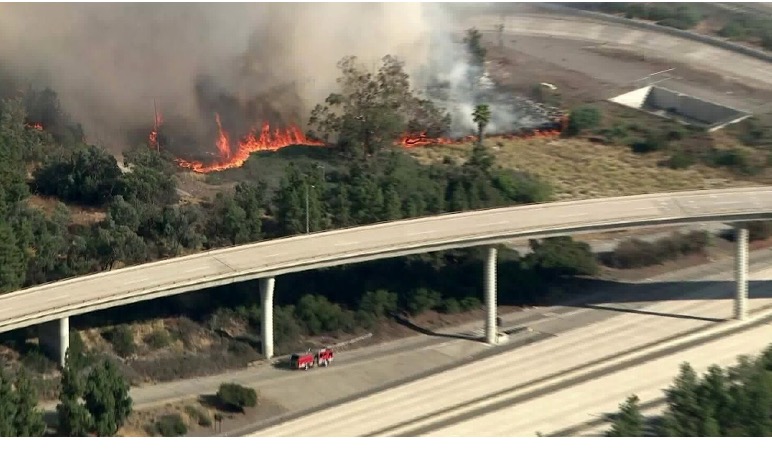CommentsACCORDING TO LIZ - It was 4:46 in the morning when the first shock shook many of the residents of Eagle Rock awake.
Many rolled over and went back to sleep – a minor trembler was not a big deal in the state awaiting the coming of the Big One which was expected to be 44 times stronger than the 6.7 magnitude earthquake that hit Northridge in 1994.
A larger aftershock less than an hour later, reported as a 5.2 on the Verdugo fault by CalTech, got many of them out of bed to comfort children and check if any dishes had fallen.
It was only the ones who ventured outdoors – checking on still sloshing pools or turning gas lines off as a guarantee there wouldn’t be any further seismic activity – who looked north to see the first harbingers of what was to come.
In the half light, they could see wisps of smoke rising north of the freeway.
Online talking heads were soon reporting a spark at the construction site of Glendale’s Biogas Renewable Generation Project had ignited adjacent scrub, tinder-dry after the long hot summer. Sirens could be heard in the distance along with the thwack-thwack-thwack of helicopters.
Winds were blowing west carrying sparks with them, flames erupting every time they touched down. Access to the area was restricted to Glenoaks Boulevard from the west and Scholl Canyon Road from the top of Figueroa.
A report came in about a pressure drop in the pipeline from the Biogas plant to Glendale’s newly updated Grayson facility indicating a possible rupture, and it was immediately shut down. Not soon enough.
Some of the flames found more fuel at the crack. Whoosh!
A huge explosion, as the adjacent pipe infrastructure was blown apart.
This got everyone’s attention. Wildfire above Eagle Rock!
Copters wheeled away as the superheated air billowed skyward. More sirens. People’s cellphones blossomed with announcements to standby for possible evacuation.
Many didn’t wait but piled kids and pets in cars and headed down to Colorado Boulevard to join the mass escape. Others quickly followed as Santa Ana winds rose and started pushing the fire across the 134 and towards homes in the hills of northern Eagle Rock.
Meanwhile in Fire Station 42, personnel were trying vainly to stop traffic long enough to get their rigs on the road. They were needed at the west end of the fire but the new permanent double concrete medians installed for the BRT lanes directly in front of the station precluded left turns.
Those that managed to bump across the bike lane bollards and BRT lane protecting bumps to head east soon came to a screeching halt behind an early bus which was itself blocked by an accident between a couple of SUVs that had tried to bypass the gridlock of the sole traffic lane.
Other cars were trying to pass in the bike lanes and on the sidewalks.
Soon there were accidents in Eagle Rock and the hills above but emergency apparatus could not even get out of the station’s driveway.

The Project as approved by Metro on April 28 includes a new double concrete median directly in front of LAFD Station #42 that will make it impossible for emergency apparatus to turn left and travel west on Colorado Boulevard, and will make even right turns more difficult and dangerous.
Dispatchers were calling off other engines that were heading into refuel. The tanker that was to make a delivery the day before had not been able to maneuver in because a truck had double parked in the access lane.
The preceding the cascade of events is fictional. But it could become a reality all too soon.
Fact: Reducing driver miles will improve quality of life
Fiction: Road diets will reduce the number of drivers on the road
Fact: Open roadways enable emergency vehicles to respond and residents to evacuate
None of these traffic calming features in the Refined F1 BRT plan for Colorado Boulevard that was recently approved by the Metro Board received approval, despite its negative implication for emergency response and evacuations.
Under Section 503.4 of the Los Angeles County Code Fire apparatus access roads shall not be obstructed in any manner, including by the parking of vehicles or the use of traffic calming devices, including but not limited to, speed bumps or speed humps. The minimum widths and clearances established in Sections 503.2.1 and 503.2.2 shall be maintained at all times.
Hilda Solis and Kevin de León spoke in support of the Metro Board’s decision; if they were unaware that reviews were not made, they should demand they be done and all issues addressed before the project moves forward.
This affects all of Los Angeles, all of California. Please contact your Councilmember and County Supervisor and ask them to pull back on instituting road diets unless a full review is made and all concerns for safety and emergency measures, for drivers and pedestrians, for children and the disabled are not only addressed but resolved in their favor.
Do not allow vocal minorities such as “road calming” enthusiasts and bicycle advocates or those who have fiscal interests in building this kind of infrastructure overrule the rights of the neighborhoods.
(Liz Amsden is a contributor to CityWatch and an activist from Northeast Los Angeles with opinions on much of what goes on in our lives. She has written extensively on the City's budget and services as well as her many other interests and passions. In her real life she works on budgets for film and television where fiction can rarely be as strange as the truth of living in today's world.)














